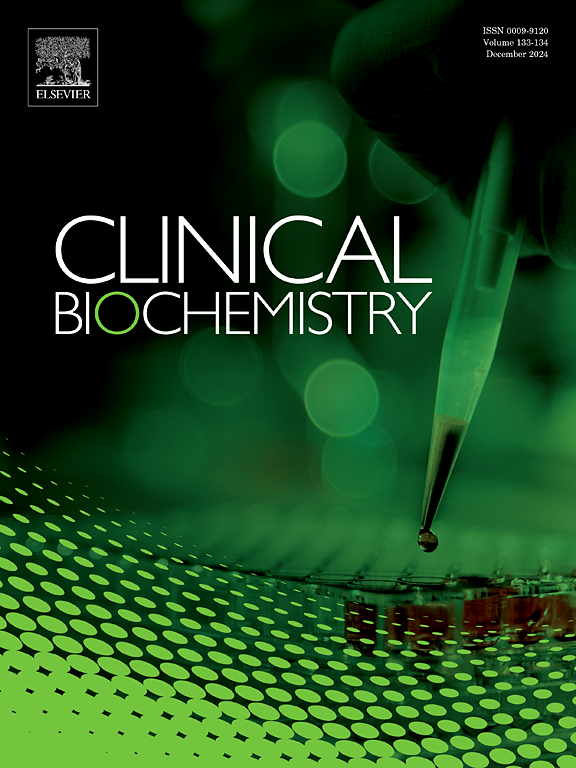Clinical relevance of the Maglumi immunoassay for anti-GAD65 in diabetes and neurological disorders: Analytical challenges and diagnostic insights
IF 2.1
3区 医学
Q2 MEDICAL LABORATORY TECHNOLOGY
引用次数: 0
Abstract
Introduction
Anti-GAD65 is an established diagnostic biomarker for autoimmune diabetes and neurological syndromes associated with GAD antibody-spectrum disorders. Automated chemiluminescence-based immunoassays such as Maglumi are increasingly used, but their behavior at high antibody concentrations remains poorly characterized. We report the analytical concordance between Maglumi and radioimmunoassay (RIA), the cut-off titer that differentiates neurological from diabetic patients, and the hook effect of the immunoassay.
Materials and methods
Anti-GAD65 levels were analyzed in samples from 90 patients with suspected autoimmune diabetes or neurological syndromes, using Maglumi 2000® and RIA (Medipan®). Analytical concordance was assessed by Passing–Bablok regression, Bland–Altman plots, and Cohen’s kappa. ROC curve analysis identified diagnostic thresholds, and dilution studies were performed in samples with unexpectedly low values to assess a potential hook effect.
Results
Maglumi results were approximately five times higher than RIA results (slope = 5.364; R2 = 0.908); agreement was higher in endocrine (R2 = 0.998) than in neurological patients (R2 = 0.891). A cutoff of 6778 IU/mL discriminated neurological patients from diabetic patients (AUC = 0.96). Sixteen samples showed a hook effect, with direct (undiluted) values ≤273 IU/mL, while the corrected titers after dilution exceeded 20,000 IU/mL. A linear regression confirmed an inverse relationship between direct and true titers (r = –0.79, p < 0.05).
Discussion
Maglumi anti-GAD65 immunoassay provides reliable discrimination between endocrine and neurological patients but requires method-specific cutoffs to avoid misclassification. Hook effect was frequent in high-titer neurological samples, potentially leading to misdiagnosis, underscoring the need for routine dilution protocols to improve diagnostic reliability.
Conclusions
Standardized dilution protocols and appropriate cutoffs are essential to ensure reliable anti-GAD65 testing with Maglumi chemiluminescent immunoassay, particularly in neurological indications.
Maglumi免疫测定抗gad65在糖尿病和神经系统疾病中的临床意义:分析挑战和诊断见解
anti - gad65是与GAD抗体谱障碍相关的自身免疫性糖尿病和神经综合征的诊断性生物标志物。基于自动化学发光的免疫测定(如Maglumi)越来越多地使用,但它们在高抗体浓度下的行为特征仍然很差。我们报告了Maglumi和放射免疫测定(RIA)之间的分析一致性,区分神经性和糖尿病患者的截止效价,以及免疫测定的钩效应。材料和方法使用Maglumi 2000®和RIA (Medipan®)分析90例疑似自身免疫性糖尿病或神经综合征患者样本中的anti - gad65水平。分析一致性采用passingbablok回归、Bland-Altman图和Cohen’s kappa进行评估。ROC曲线分析确定了诊断阈值,并在出乎意料的低值样本中进行稀释研究,以评估潜在的钩效应。结果smaglumi结果比RIA结果高约5倍(斜率= 5.364,R2 = 0.908);内分泌组的一致性(R2 = 0.998)高于神经系统组(R2 = 0.891)。6778 IU/mL的临界值将神经系统患者与糖尿病患者区分开来(AUC = 0.96)。16个样品呈钩效应,直接(未稀释)值≤273 IU/mL,而稀释后的校正滴度超过20,000 IU/mL。线性回归证实了直接滴度和真实滴度之间的反比关系(r = -0.79, p < 0.05)。maglumi anti-GAD65免疫测定提供了内分泌和神经系统患者之间可靠的区分,但需要方法特异性的截止以避免误分类。Hook效应在高滴度神经学样本中很常见,可能导致误诊,强调需要常规稀释方案来提高诊断可靠性。结论:标准化的稀释方案和适当的截止点对于确保Maglumi化学发光免疫分析法可靠的抗gad65检测至关重要,特别是在神经系统适应症中。
本文章由计算机程序翻译,如有差异,请以英文原文为准。
求助全文
约1分钟内获得全文
求助全文
来源期刊

Clinical biochemistry
医学-医学实验技术
CiteScore
5.10
自引率
0.00%
发文量
151
审稿时长
25 days
期刊介绍:
Clinical Biochemistry publishes articles relating to clinical chemistry, molecular biology and genetics, therapeutic drug monitoring and toxicology, laboratory immunology and laboratory medicine in general, with the focus on analytical and clinical investigation of laboratory tests in humans used for diagnosis, prognosis, treatment and therapy, and monitoring of disease.
 求助内容:
求助内容: 应助结果提醒方式:
应助结果提醒方式:


